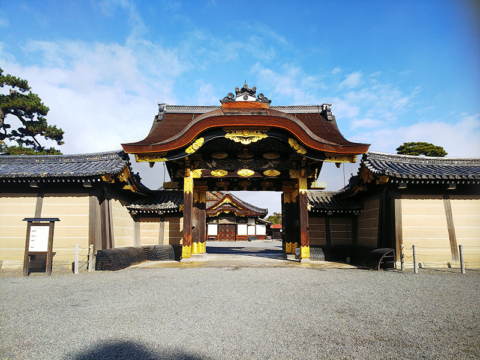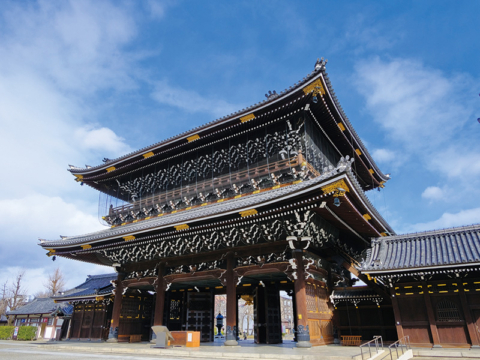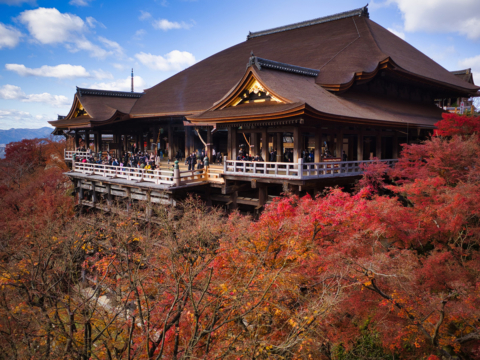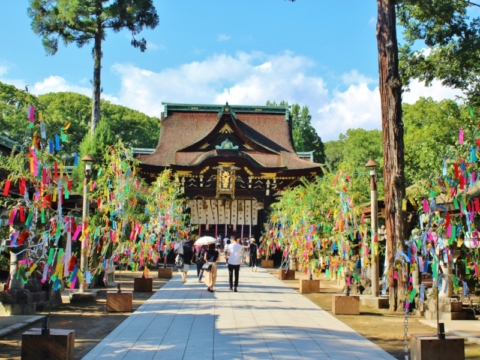LOCATION
 Nijo Castle
Nijo CastleNijo Castle was built in 1603 by Ieyasu Tokugawa, the first shogun of the Edo Shogunate, to protect the Kyoto Imperial Palace, where the emperor resided, and also to provide a place for the shogun to stay during his visits to Kyoto from Edo (Tokyo). It was registered as a UNESCO World Heritage Site in 1994, and is a precious historical heritage that has witnessed the rise and fall of the Tokugawa family.
Approximately a 12 minute walk
Name Nijo Castle Address 541 Nijojo Castle-cho, Nijo-dori Horikawa-nishiiru, Nakagyo-ku, Kyoto 604-8301 Tel 075-841-0096 URL https://nijo-jocastle.city.kyoto.lg.jp/  Arashiyama
ArashiyamaArashiyama is a 382-meter-high mountain in the western part of Kyoto City. However “Arashiyama” actually includes few surrounding mountains besides itself such as Matsuoyama and Karasugatake that are on the west side across the Oigawa River, and Ogurayama and Kameyama on the east side, and the foot of the three mountains. Thus the entire area including the foot of the mountain is generally called Arashiyama, and the foot of the mountain is a tourist attraction with many temples and shrines.
Approximately a 9 minute train ride from JR Nijo Station.
Name Arashiyama Address 40, Sagano-baba-cho, Tenryuji, Saga, Ukyo-ku, Kyoto 616-8385, Japan Tel 075-861-0012 URL http://www.arashiyamahoshokai.com/  Kinkakuji Golden Pavilion Temple
Kinkakuji Golden Pavilion TempleIt is said that Ashikaga Yoshimitsu, the third shogun of the Muromachi Shogunate, took it over and built Kitayama-den, a mountain villa. Each of the three layers has a different structure, and the second and third layers are covered with pure gold leaf over lacquer. The “upside-down Golden Pavilion” reflected in Kagamiko Pond in front of the Golden Pavilion is also beautiful.
The garden, which is made in the typical style of the Muromachi period (1336-1573), and the sukiya-style tea ceremony house “Yukatei” are also highlights of the temple.Approximately a 15 minute ride on Kyoto City Bus
Name Kinkakuji Golden Pavilion Temple Address 1 Kinkakuji-cho, Kita-ku, Kyoto, 603-8361, Japan Tel 075-461-0013 URL https://www.shokoku-ji.jp/kinkakuji/  Ninna-ji Temple
Ninna-ji TempleNinna-ji Temple is the head temple of the Omuro school of Shingon Buddhism, founded in 888. After flourishing in the Kamakura period (1185-1333), most of the temple was destroyed by fire during the Onin War (1467-1568), but was rebuilt in 1634 with the support of Tokugawa Shogun Iemitsu.
The precincts of the temple are lined with historical buildings erected in the Edo period, including a five-story pagoda and the Nioimon Gate. Since its founding, the temple has also housed many treasures, including the principal worship statue of Amida Sansonzon, Buddhist paintings, and artifacts.
Approximately a 16 minute train ride from JR Nijo Station.
Name Ninna-ji Temple Address 33 Omuro-Ouchi, Ukyo-ku, Kyoto-shi, Kyoto 616-8092 Tel 075-461-1155 URL https://ninnaji.jp/  Higashi Honganji Temple
Higashi Honganji TempleIt is the head temple of the Shinshu Otani sect of the Jodo Shinshu Buddhism and is called “Shinshu Honbyo” or commonly known as “Higashi Honganji Temple.
The Mikagedo Hall houses the image of Shinran Shonin, the founder of the sect, and the Amida Hall houses the Amida Nyorai, the principal image of the sect. After the death of Shinran Shonin, the founder of the sect, many people who adored him built a mausoleum to enshrine his image at the site of his grave, which was the beginning of Higashi Honganji.
Approximately 15 min. by Kyoto City BusName Higashi Honganji Temple Address 754 Tokoha-Cho, Karasuma-Dori ShichijoAgaru, Shimogyo-Ku, Kyoto-City 600-8505 Tel 075-371-9181 URL https://www.higashihonganji.or.jp/  Kiyomizu Temple
Kiyomizu TempleFamous for its “Kiyomizu-no-butai” (stage of Kiyomizu), this temple is registered as one of the World Heritage Sites under the category of Cultural Properties of Ancient Kyoto.
In addition to the main hall where the stage is located, other famous sites include the Niomon Gate, the three-story pagoda, and the Otowa Waterfall.
Approximately 30 minutes by Kyoto City Bus
Name Kiyomizu Temple Address 1-294, Kiyomizu 1-chome, Higashiyama-ku, Kyoto 605-0862 Tel 075-551-1234 URL https://www.kiyomizudera.or.jp/  Kitano-Tenmangu Shrine
Kitano-Tenmangu ShrineKitano Tenmangu Shrine is a Shinto shrine in Kyoto, famous for its plum blossoms and autumn leaves. It is the main shrine enshrining Sugawara no Michizane, and is popularly called “Tenjin-san” and widely worshipped as a shrine to pray for success in entrance examinations, academic achievement, culture and the arts, and protection from calamities and misfortune.
Approximately 18 minutes by Kyoto City Bus
Name Kitano-Tenmangu Shrine Address Bakurocho, Kyoto Shi Kamigyo Ku, Kyoto 602-8386 Tel 075-461-0005 URL https://kitanotenmangu.or.jp/  Fushimi Inari Taisha Shrine
Fushimi Inari Taisha ShrineFushimi Inari Taisha, affectionately known as “Oinari-san,” is the head shrine of about 30,000 small Inari shrines throughout Japan. It is said to have been founded in 711, which is earlier than the capital city of Heian period (794-1185) was moved to Kyoto from Nara. The shrine is said to be blessed with prosperity in business and safe home, and attracts many worshippers throughout the year.
25 minutes from JR Nijo Station by train
*Including transfer timeName Fushimi Inari-taisha Shrine Address 68 Fukakusa Yabunouchi-cho, Fushimi-ku, Kyoto 612-0882 Tel 075-641-7331 URL http://inari.jp/

